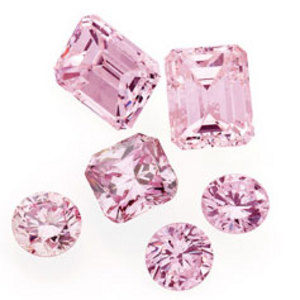Pink diamonds were relatively unknown until 1985, when the Argyle diamond mine began production. Today, over 90 percent of the world’s pink diamonds are derived from this 110-acre mine in Western Australia.
The Argyle diamond mine produces more than 35 million carats of diamonds annually. Less than one percent is pink diamonds. Additionally, the pink diamonds found in this region have been dated back more than one billion years, making them extremely rare and highly valuable.
Pink diamonds command premium prices in the marketplace. The price per carat is based on the cut, color and clarity of the diamond. A premium pink diamond can fetch a price of $100,000 per carat or more.
Many factors are considered when determining the cut of pink diamonds. Gemologists use a variety of tools including binocular microscopes and spectroscopes to assess diamond anatomy. The cut is based on the height and width of the diamond and signifies its brilliance. The brilliance determines how light travels within the diamond and ultimately affects its sparkle and shine.
Pink diamonds are graded on a scale of one to eight, with one being the most intense color and eight being the lightest shade of pink. Pink diamonds are ranked in order of rarity and include color ranges of purplish-pink, pink, brownish pink and pink champagne.
When shopping for pink diamonds it’s important to adhere to the four “C’s” criteria – carat, clarity, color and cut.
Carat
Carat refers to the weight of the diamond. One carat equals 0.2 grams and 100 points. If a diamond has 10 points, it is equal to one-tenth of a carat. If it has 50 points, it is equal to one-half carat, and so on. The price of diamonds is not solely based on the carat weight. For instance, a flawless one-carat pink diamond costs significantly more than a flawless one-carat colorless diamond.
Clarity
Clarity refers to how light is reflected and refracted within the diamond. If a diamond is flawless, nothing disrupts the flow of light. However, if the diamond has bubbles, cracks, carbon or mineral deposits, a portion of the reflected light will be lost.
Diamond clarity is based on identifying characteristics known as inclusions. Typically, inclusions are invisible to the naked eye and require the use of a jeweler’s loupe. A jeweler’s loupe allows experts to view natural occurrences within the diamond such as crystals, feathers, and clouds. The type, size and amount of inclusions determine the grade of clarity.
When selecting diamonds, it’s important to become familiar with the diamond clarity scale. There are five categories of clarity, along with two to three subcategories in each class.
First and foremost is the flawless diamond. There are two types of flawless diamonds — flawless and internally flawless. Flawless diamonds are graded as ‘FL’ and reveal no surface or internal flaws. FL diamonds are the rarest and most beautiful diamonds of all. Of course, their price tag reflects this.
Internally flawless diamonds are graded as ‘IF’ and reveal no internal inclusions. It is acceptable for IF diamonds to have insignificant surface blemishes, which typically can only been seen under magnification of the jeweler’s loupe.
The next grade of clarity includes “Very, Very Slightly Included” which means inclusions are very difficult to see under magnification. These diamonds are rated as ‘VVS1’ or ‘VVS2’.
Following this grade is “Very Slightly Included” where inclusions are nearly impossible to see with the naked eye. Considered middle-of-the-road, this grade of diamonds is typically less expensive than VVSI and VVS2 grade diamonds. Very Slightly Included diamonds are rated as ‘VS1’ or ‘VS2’.
When diamonds reveal inclusions that can easily be identified using a jeweler’s loupe, they are classified as “Slightly Included.” Typically, flaws cannot be seen with the naked eye. These diamonds are graded as ‘SI1’ or ‘SI2’.
Last, but not least, is the “Imperfect” grade which includes diamonds with inclusions that may or may not be visible to the naked eye. The flaws on Imperfect stones will have some effect on the brilliance of the diamond. Imperfect diamonds are graded as ‘I1’, ‘I2’, or ‘I3’.
Color
Color refers to the intensity or lack of color in a diamond. Diamond colors are graded using an alphabetical scale of D to Z.
Colorless diamonds are graded as D, E, or F; with D being the most valuable.
Near colorless diamonds are graded as G, H, I, or J and may have shades of yellow, grey, or brown.
Faint yellow diamonds are graded as K, L, or M; with K having the lightest tint.
Very light yellow diamonds are graded as N, O, P, Q and R.
Light yellow diamonds are graded as S through Z.
Diamonds graded higher than Z enter into the category of fancy color diamonds, such as seen with pink diamonds. A fancy color diamond is significantly more valuable than a D colorless diamond because of its rarity.
Cut
Finally, cut refers to the way a diamond is transformed from its natural, rough state into a polished gem. Jewelers can shape a diamond into various forms including the classic round-cut and highly sought-after marquise-cut.
The way a diamond is cut will affect its brilliance and clarity. When a diamond is well cut, it will refract light internally and reflect it through the top of the stone. If a diamond is not well cut, light will reflect through the bottom or sides of the stone, affecting its brilliance.
Investing in Pink Diamond Jewelry
When looking for pink diamond jewelry, it’s important to keep in mind that pink diamonds are an investment. On average, the value of pink diamonds increases between 10 and 15 percent annually. Currently, the demand for natural colored diamonds is strong with the market seeing price increases of more than 25 percent.
Locating high-quality pink diamonds will require research. Many pink diamonds offered at local jewelry stores are actually stones treated with High Pressure-High Temperature (HPHT) to improve color.
At present, there is no tool available to identify treated stones. However, according to Federal Trade Commission guidelines, jewelers must disclose any alterations made to the stone that affect its price. When shopping for pink diamonds, always inquire if the stone has been altered in any way.
Another form of pink diamonds is synthetic or cultured. These stones are grown in laboratories and enhanced with HPHT. Cultured diamonds are considered real diamonds; however, they come with a considerably lower price tag. Only purchase cultured pink diamonds that are certified by an independent gemological laboratory.
Real pink diamonds are worth the hunt. Not only are they stunningly beautiful, they are a sound investment and can be passed on from generation to generation. Thoroughly research diamond dealers and obtain certification before purchasing any diamonds; particularly those that are pink.
Reference:
- Argyle Diamonds – www.argylediamonds.com.au/




